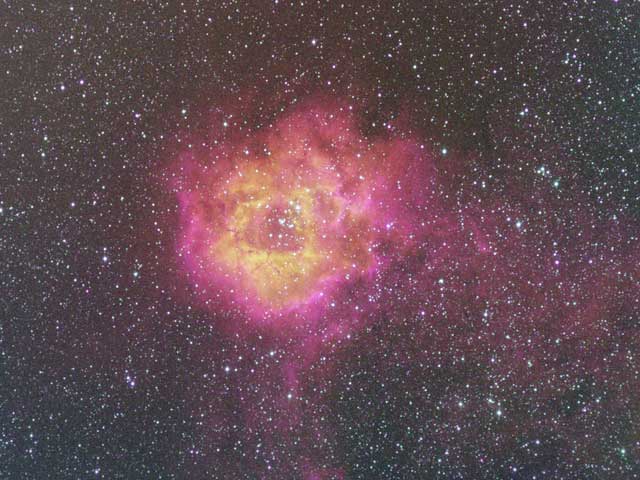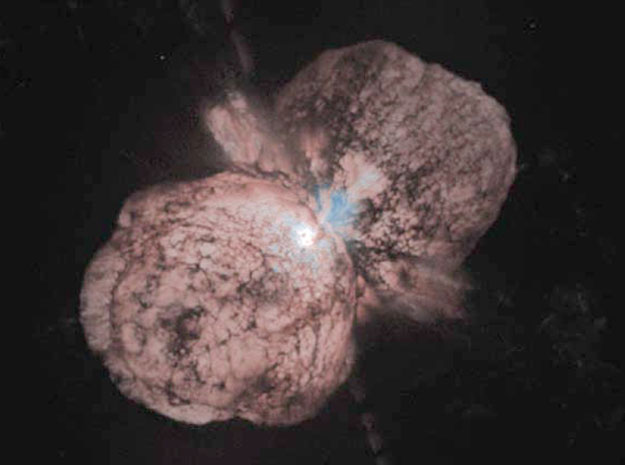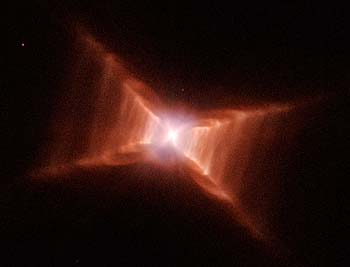<>
A star begins its life in the form of a Giant Molecular Cloud. The density of empty
space is around 0.1 to 1 particles per cm3; the cloud, on
the other hand, contains hundreds per cm3. The cloud is
stable, but its molecules are too widely spaced for gravity to
draw them closer, until a supernova
explodes nearby, sending out a shockwave of successive compression
forming knots of matter or cores of greater density. When density
exceeds 100,000 atoms / cm3, gravity takes over and
the region begins to collapse into a protostar (each dense core will produce anywhere
from 1 protostar to tens of thousands). The atoms gain speed in their
fall toward the center, providing the protostar with heat and a weak infrared glow. In some
protostars, contraction remains the only source of energy; these are
brown dwarfs, and they die away slowly, over hundreds of billions of
years (did I say slowly?). If a protostar is massive, though, if matter
at the center has enough on top of it, then the threshold is around 15 MK (15 million degrees Celsius) and the electrons are stripped from their
parent atoms, creating a plasma. Contraction continues, and
eventually the speed of the atomic nuclei is great enough to overcome
the electrical repulsion keeping them apart and nuclear fusion
occurs: hydrogen nuclei fuse
to form helium in the proton-proton
chain or by the CNO cycle.
In doing so the protostar gives off a tremendous amount of energy,
which pours out from the core, setting up an outward pressure in the
gas around it that balances the inward pull of
gravity, stopping the protostar's contraction. When the energy reaches
the outer layers, it continues into space in the form of electromagnetic
radiation and among other things, visible light.
< style="color: rgb(255, 204, 0);">
Credit & Copyright: Richard Crisp (narrowbandimaging.com)
< style="color: rgb(255, 204, 0);">
<
style="color: rgb(255, 204, 0);">When a star is formed, it takes on a
color from blue to red that depends on its temperature, composition,
and mass.The future of the
star depends on which road it takes; either allowing gravity to
overcome its fusion reaction that pushes out or the opposite. When a
star forms and takes its position it will rest there for a period of
millions (for the biggest and hottest stars) to billions (for mid-sized
stars like the Sun) to tens or hundreds of billions (for red dwarfs) of
years, expending most of the hydrogen in its core. Eventually the supply
of hydrogen runs out and the star begins its demise. Once the star's
hydrogen runs out there will be no more nuclear processes and therefore
no outward presssure. The outer layers of the star will begin to
collapse and during the process the temperature and pressure increase
forcing helium fusion. This heat temporarily counteracts gravity and
the outer layers expand as much as 100 times its original size, being
known as a red giant. What happens next depends on the star's mass. If
the star has a relatively low mass, then all scientists have to go upon
is theory and computer generations that predict either red or brown
dwarfs because as a small star, it would burn its fuel less quickly and
live much longer. The universe as we know it is too young and
this has not happened yet.

Doomed Star Eta Carinae
Credit: J. Morse (Arizona State U.), K. Davidson (U. Minnesota) et al., WFPC2, HST, NASA
If the star is about .4-1.4 times the mass of the Sun then its fate is a white dwarf, where it undergoes a red giant phase and then shrinks to about 20% of its original mass and cools for millions of years until it becomes a black dwarf, but none of these exitst yet due to the age of the universe. The fate of large stars is known to be one of the most remarkable, but not completely understood phenomenae in the universe, the super novae. The star first takes the form of a red supergiant and causes a series of nuclear reactions causing the combination of its heavier elements, and therefore removing its reaction capability and then losing its ability to counteract gravity. What happens next is not clearly understood, but a super novae takes place in matters of a fraction of a second. Its neutrinos send a shockwave out blasting most of the stars materials into space, but many of the elements get caught up in neutrinos and combine to create heavier elements. Without supernovae there would be no heavier elements than Iron-56.


Credit: J. Morse (Arizona State U.), K. Davidson (U. Minnesota) et al., WFPC2, HST, NASA
If the star is about .4-1.4 times the mass of the Sun then its fate is a white dwarf, where it undergoes a red giant phase and then shrinks to about 20% of its original mass and cools for millions of years until it becomes a black dwarf, but none of these exitst yet due to the age of the universe. The fate of large stars is known to be one of the most remarkable, but not completely understood phenomenae in the universe, the super novae. The star first takes the form of a red supergiant and causes a series of nuclear reactions causing the combination of its heavier elements, and therefore removing its reaction capability and then losing its ability to counteract gravity. What happens next is not clearly understood, but a super novae takes place in matters of a fraction of a second. Its neutrinos send a shockwave out blasting most of the stars materials into space, but many of the elements get caught up in neutrinos and combine to create heavier elements. Without supernovae there would be no heavier elements than Iron-56.

Courtesy of: NASA, ESA, Hans Van
Winckel, Martin Cohen
It
is not understood well, but in some supernovae the gravity is so
intense within the red supergiant that the electrons are forced into
the atomic nuclei where they combine with protons to form neutrons. The
electromagnetic forces keeping apart the seperate nuclei are gone and
the entire core becomes a dense ball of neutrons or an atomic nucleus
about the size of Manhatten called a Neutron
Star. If the mass is great enough though, when the star turns
into a red supergiant it will collapse under its on gravity into a
radius smaller than the Schwarzchild
Radius and turn into a Black
Hole.